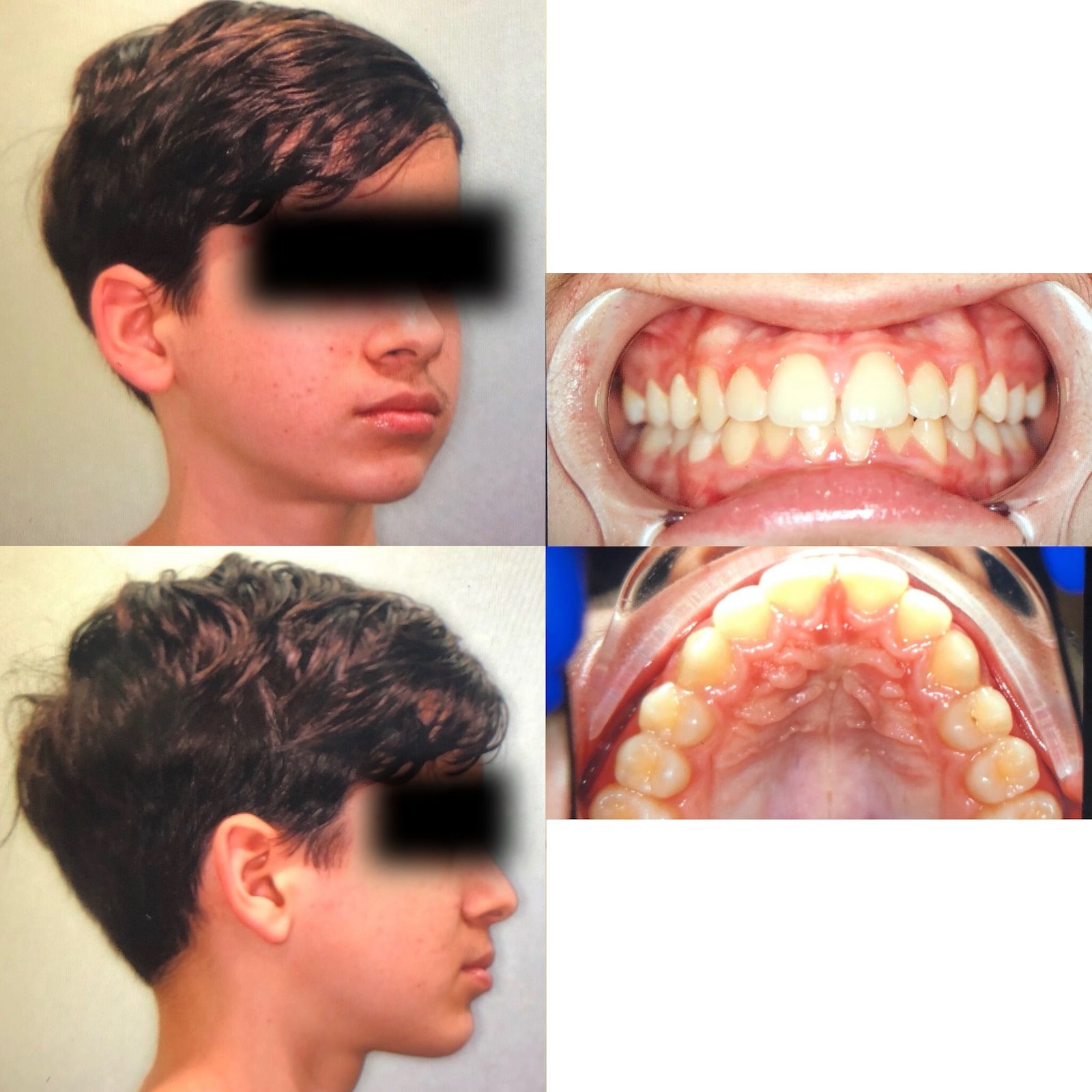Buck Teeth: The Causes and Treatment for Buck Teeth
Buck Teeth - What are They?
Buck teeth are symbolic of a pronounced
overbite
- otherwise known as a class 2, division 1 malocclusion - where the upper teeth protrude over the lower teeth. The term 'buck teeth' refers
to how the front teeth stick out - often in front of the bottom lip.

A classic case of buck teeth seen in one of our young patients. Continue reading to see the results.
What Causes Buck Teeth?
Buck teeth occur where the lower jaw fails to develop correctly and is positioned too far back in the face. This is what causes the top jaw to overshoot it. Understanding what causes buck teeth is a matter of understanding why the lower jaw fails to grow properly. Traditional dentists and orthodontists believe that this stunted growth of the lower jaw is simply genetic; however, this fails to consider how poor facial posture (specifically poor tongue posture) and habits influence the development of the face.
Buck Teeth are Caused by Improper Tongue Posture
The reality is that stunted jaw growth and buck teeth are often caused by improper tongue posture - specifically a low tongue posture where the tongue sits away from the roof of the mouth.
Ideally, the tongue will be positioned on the roof of the mouth. The tongue is the strongest and most important muscle in the mouth, so when it sits on the roof of the mouth, it exerts pressure on the top jaw. This pressure keeps the top jaw wide and is conducive to forward growth of the face. When the tongue is positioned on the roof of the mouth like this, the lower lips will be sealed, and the lower jaw will be in touch with the top jaw, and both will grow forward. Remember, buck teeth occur where the lower jaw fails to grow forward.
Conversely, when the tongue sits away from the roof of the mouth, the top jaw will narrow and be dragged down - also forcing the lower jaw to narrow and be dragged down. Ultimately, a low tongue posture causes the face to grow in a downwards fashion. When the face grows down like this, both jaws get stunted backwards, especially the lower jaw - which gets trapped behind the top jaw, ultimately causing buck teeth.

Notice how narrow the top jaw is and how the front teeth protrude over the bottom teeth.
Buck Teeth From Thumb Sucking
One of the leading causes of low tongue posture is thumb sucking. During the act of thumb sucking, the thumb is pushing the top front teeth up and forward while simultaneously pushing the bottom front teeth down and back. Essentially, the teeth mimic the shape of the thumb.
What's more, thumb sucking forces the tongue away from the top of the mouth - resulting in a low tongue posture. During thumb sucking, children will end up using their cheek muscles (buccinators), and the lower lip (mentalis), so habitual thumb sucking can lead to the over-development of these muscles and the weakening of the tongue. This ultimately means the cheeks are used on swallowing instead of the tongue, which further narrows the top jaw. Thus, it is common for children to develop buck teeth from thumb sucking.
Buck Teeth From Mouth Breathing
Another habit that tends to cause a low tongue posture and buck teeth is mouth breathing. When the mouth is open, the tongue is dragged down from its optimal resting place on the roof of the mouth. So, if the mouth is open regularly for breathing, the face will tend to grow in a downwards fashion, ultimately stunting the lower jaw back in the face and causing buck teeth.

Buck Teeth From How Allergies and Breathing Issues
For many - especially children - mouth breathing isn't a choice but a necessity. This is because they often suffer from allergies or other health complications that create airway issues - making nasal breathing either very difficult or impossible. Unfortunately, this link between airway issues and buck teeth is often missed by most dentists and orthodontists, as many fall into the trap of thinking buck teeth are a genetic issue.
Buck Teeth are More Than an Aesthetic Problem
Buck teeth are known for being aesthetically displeasing; however, they also pose many health concerns. From a functional standpoint, buck teeth are often indicative of jaw joint and airway issues. When the lower jaw is stunted back in the face, the risk for TMJ dysfunction heightens. In low tongue posture, the tongue often ends up blocking the airway, resulting in reduced oxygen supply. This can cause snoring and sleep apnea and lead to other developmental issues that arise due to limited oxygen supply.
Finally, buck teeth pose a trauma risk - especially in children. If the teeth are sticking out, they tend to be chipped, cracked or knocked out more often.

How To Fix Buck Teeth
As buck teeth are caused by the lower jaw being positioned too far back in the face, fixing buck teeth is a matter of correcting facial posture - specifically the jaws. At Eric Davis Dental, we typically treat buck teeth with orthotropics. Our objective when treating buck teeth is to expand the upper jaw to create enough room for the tongue and then encourage the child to breathe through their nose and keep their lips sealed. Doing this over time will correct their tongue posture and free up the bottom jaw to grow forwards - ultimately allowing it to reconnect with the top jaw.
We don't typically use braces or other common orthodontic appliances when we fix buck teeth. Braces are designed to straighten the teeth - whereas what we are doing is correcting the posture of the face. Instead, we use a series of removable appliances for the express purpose of correcting posture.

Notice that the top jaw is much wider than in the above photo. This is critical in fixing buck teeth.
What Most Dentists and Orthodontists Get Wrong About Fixing Buck Teeth
Unfortunately, many dentists don't recognise the role that facial and tongue posture plays in buck teeth. Because they believe that buck teeth are caused by genetics, they think that there is nothing they can do to correct them until the child has finished growing their adult teeth (around the age of 12-13).
Because they believe they have no control over the growth of the bottom jaw, they tend to correct buck teeth by pulling the front teeth back with appliances like braces. If the teeth are exceptionally crowded, they may even remove teeth. This approach achieves suboptimal results, as it fails to correct the underlying cause of buck teeth, which is a lower jaw that is positioned too far back in the face. Thus, even though the front teeth may no longer stick out, many associated conditions such as airway issues and TMJ dysfunction will persist.
Treating Buck Teeth With Orthotropics
By comparison, orthotropics prefers to treat buck teeth from a very young age - around 6 or 7. The approach is to
treat the cause rather than the symptoms - meaning orthotropics will focus on developing the jaw instead of simply
straightening the teeth. Because orthotropics looks to improve the position of the jaws, it yields better results on every front from aesthetics to function.

